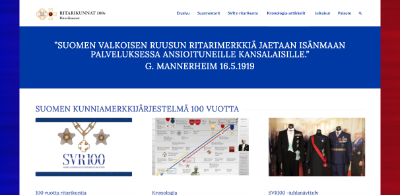On the history of the orders
See also
The decorations of Finland’s three Orders are awarded on a comprehensive and wide-ranging basis to citizens who have distinguished themselves in services to the country in different fields. While the orders of knighthood trace their origins back to the Middle Ages, today’s orders of merit, which are merit-based and with multiple categories, developed gradually from the end of the seventeenth century.
General history of the orders of knighthood
The simple cloth crosses of the religious orders of knighthood, originally worn on cloaks at the time of the Crusades, served more as a badge of membership than as a decoration. There were also monarchical orders of knighthood established from the early fourteenth century onwards. Their principal insignia were typically jewel-like medallions. From the late sixteenth century, however, the eight-pointed, white Maltese cross used by the Knights of St John became commonly used as a symbol by monarchical orders of knighthood.
Deviating from these single-class monarchical orders, which were retained up to the end of the seventeenth century, modern orders of merit adopted the hierarchical structure used by the religious orders of knighthood and also the names of certain offices (e.g. Grand Master) and classes (e.g. Commander). However, the idea behind the insignia of the religious orders of knighthood was almost completely the reverse of the underlying principle in today’s orders of merit. The precious metal and enamel crosses of today’s orders of merit are primarily decorations recognising the bearer’s merits, rather than indications of the membership of an order. The closer we get to the present day, the weaker the ‘membership’ nature of the orders, especially the orders of merit.
Orders of merit
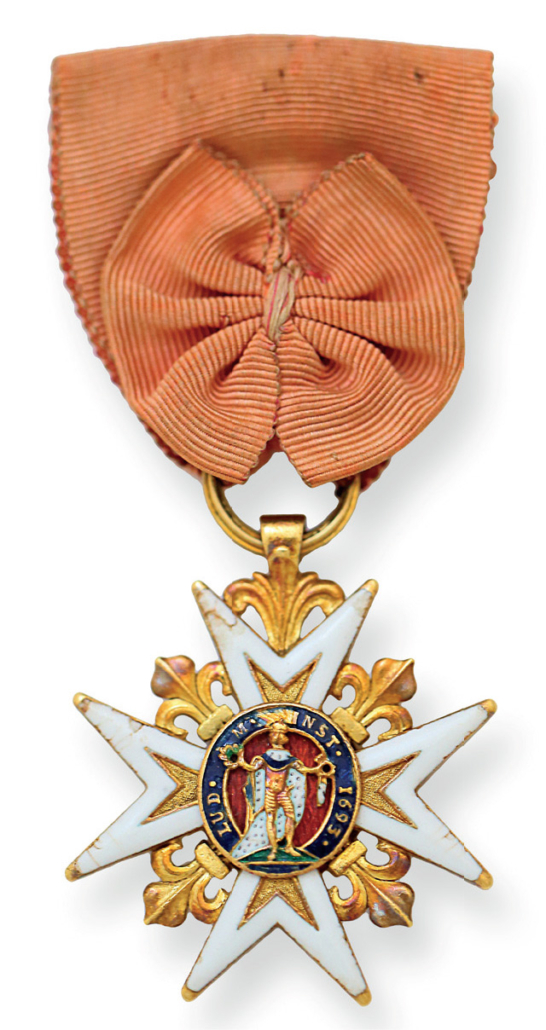
A Knight’s Cross of the Order of Saint Louis of France. This type of ribbon bow, which was originally an emblem indicating that the knight is receiving the pension of the Order, later became the round rosette used in many orders to indicate an officer class or Knight First Class.
The clearest turning point in the early development of the orders as a modern institution was the creation in 1693 of the first multiclass order of military merit, the French Order of Saint Louis. The number of holders of the two highest classes of the Order – Commander Grand Cross and Commander – was restricted, but any Roman Catholic officer (even a non-noble) who fulfilled the criteria could be appointed a Knight of the Order. France also led the tendency to expand the membership of the orders by accepting members from the arts, science and commerce. With orders of knighthood being key symbols of the sovereignty of rulers, a common motivation for establishing new orders of knighthood was the management of international relations and demands for the diplomatic exchange of decorations.
In the eighteenth century, the importance of discharging duties with distinction and displaying courage grew within the orders, as did secularization (though at a slow pace). Decorations of the Military Order of Maria Theresa, established in Austria in 1757, were awarded on the basis of eyewitness evidence to officers distinguishing themselves in acts of valour, irrespective of their social background and religious conviction. This completely secular order was one of the main prototypes for today’s orders of merit. Orders of merit in the republics of today that honour civilians quite extensively too can be traced back primarily to the French Legion of Honour, founded by Napoleon in 1802. As Napoleon put it, the same decoration could, for the first time, equally be awarded to an illiterate soldier as to an intellectual.
Swedish and Russian Orders
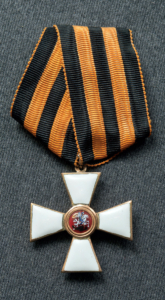
The Russian Order of St George, 4th Class, awarded to Mannerheim.
Photograph: Mannerheim Museum/Matias Uusikylä.
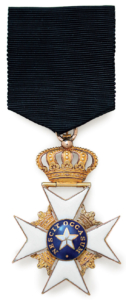
A Knight’s Cross of the Order of the Polar Star of Sweden.
Modelled on the French Orders of the Holy Ghost, Saint Louis and Saint Michael, the single-class Order of the Seraphim was established in Sweden in 1748, along with the following, originally two-class, orders: the Order of the Sword, awarded for military merit, and the Order of the Polar Star, awarded principally for civic merits. Sweden’s fourth order, the Order of Vasa, was founded in 1772 as a three-class order. At the same time, a third class was added to the Orders of the Sword and the Polar Star.
The Order of Vasa was always a free order, the decorations of which were awarded to, for example, representatives of commerce, agriculture and the arts, irrespective of birth or social status. In 1788, a special class, Knight Grand Cross, was established in the Order of the Sword for meritorious military conduct in wartime and was subsequently divided into two classes. This special class served as the model for the Finnish Mannerheim Cross, established in 1940. The wearing of Swedish decorations continued in the Grand Duchy of Finland after Sweden ceded Finland to Russia in 1809.
With Finland then an autonomous Grand Duchy of the Russian Empire, Russian decorations were duly awarded to Finns distinguishing themselves in services to the empire and the Grand Duchy. The founding of the Russian orders of knighthood began in the late seventeenth century and these developed into quite a complex system. There were eventually six Russian orders and the conferral of their decorations followed a hierarchical arrangement. These orders were the Orders of St Andrew, St Alexander Nevsky, the White Eagle, St Vladimir, St Anne and St Stanislaus. Outside the hierarchy were the Order of St Catherine, reserved for high-ranking ladies, and the Order of St George, the decorations of which were awarded to officers primarily for meritorious military conduct in wartime.
Russian orders were highly regarded in Finland until the policy of russification began during the reign of Emperor Nicholas II. Since Finland gained her independence in 1917, the insignia of Russian imperial orders have scarcely been worn at all, and authorisation to wear them on Finnish military uniforms has never been offcially granted. Mannerheim did, however, wear his Russian orders on his uniform from the 1920s until the 1940s, though naturally, given his standing, permission was not requested for this. Russian imperial orders were nevertheless mentioned in the State Calendar of Finland for as long as the Calendar included recipients of these decorations. The last such mention was in 1962.
The Order of the Cross of Liberty
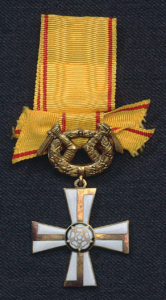
Cross of Liberty Second Class with Swords, 1918.
The Senate of Finland established the Crosses of Liberty and the Medals of Liberty on 4 March 1918 following proposals put forward by General of the Cavalry Mannerheim, Commander-in-Chief of the Finnish Military Forces. Mannerheim declared that the Cross of Liberty was established for the purpose of denoting and rewarding the heroic acts of soldiers on the battlefield and the self-sacrifice undertaken to lay the foundations for the liberty of Finland. As commanded by Mannerheim, and following his detailed guidelines, renowned Finnish artist Axel Gallen-Kallela designed the Crosses of Liberty and the Medals of Liberty. The highest classes of the Cross of Liberty incorporate a white cross similar to that of the Russian Order of St George. Gallen-Kallela superimposed on this a straight swastika, which was declared to be “a symbol of the sun, life and freedom, a symbol of many nations”, and placed a heraldic rose at the centre. In the manner of the Russian Order of St George, the Cross of Liberty has four numbered classes, but it also has a Grand Cross in the Western European tradition. When, in January 1919, a new class was added to the Cross of Liberty, namely First Class with Star, the wearing of the Order’s four highest decorations corresponded to the classes of the Order of St George.
On 28 January 1919, having considered that the Cross of Liberty had fulfilled its purpose since Finland had gained her freedom and sovereign independence, Regent Mannerheim discontinued its conferral. However, the Cross of Liberty was reinstated during the Winter War, and a permanent Order of the Cross of Liberty was founded by decree on 16 December 1940. Mannerheim became the Grand Master of the Order for life. Since Mannerheim’s death, the Grand Mastership of the Order of the Cross of Liberty has been vested in the Commander-in-Chief of the Finnish Defence Forces, that is to say the President of the Republic of Finland. On 18 August 1944, Mannerheim, as President of the Republic, issued a decree ratifying the statutes of the Order of the Cross of Liberty, and these are still in force today. The decorations of the Order of the Cross of Liberty are awarded for military merit and to civilians for distinguished actions in support of the Finnish Defence Forces. No Crosses of Liberty were conferred for peacetime merits in the period 1960–1988, apart from a few exceptional cases.
The Orders of the White Rose of Finland and the Lion of Finland
Prior to Mannerheim assigning him the task of designing decorations, Gallen-Kallela had, of his
own accord on 2 February 1918, sketched out on the lid of a box of cigarettes a design for a decoration he called the “Suomen Ruusun Kunniakunta” (‘Honorific Order of the Rose of Finland’).
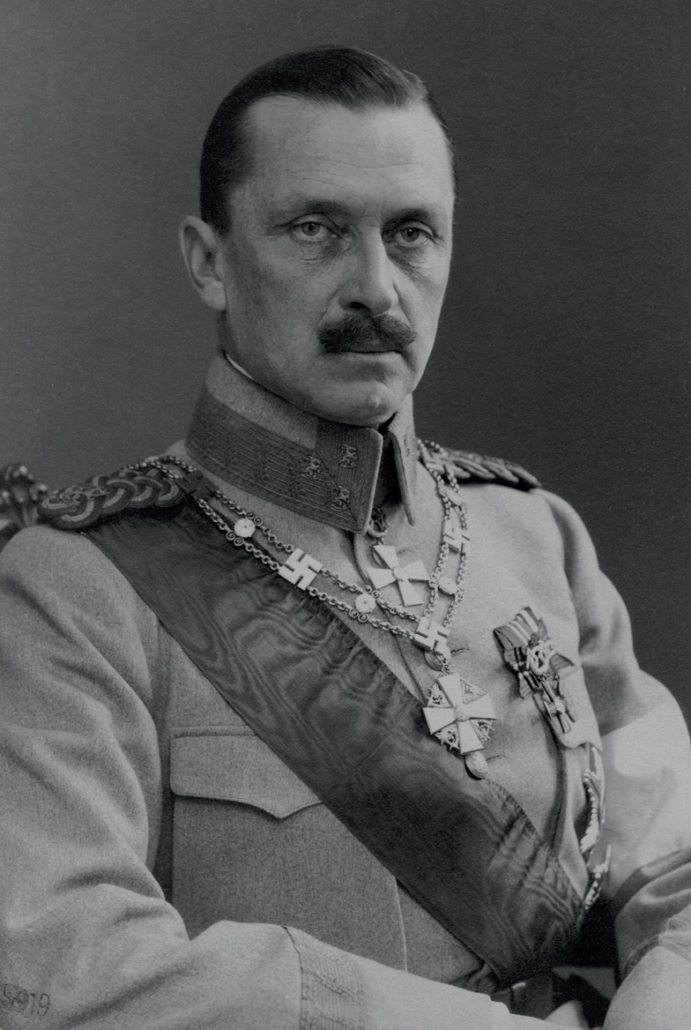
Regent G. Mannerheim, establisher of the Order of the White Rose of Finland.
When discontinuing the conferral of the Cross of Liberty in 1919, Mannerheim made the decision “to retain the white cross in somewhat altered form using the name White Rose of Finland”. Gallen-Kallela was given the task of expeditiously designing the decorations for this new Order. The first decorations were required to be ready for Regent Mannerheim’s visit to Stockholm, which began on 12 February 1919.

‘Honorific Order of the Rose of Finland’. Gallen-Kallela’s sketch on the lid of a cigarette box, dated 2 February 1918, and accompanying notes. Photograph: Per Johan Lundsten.
A white enamelled cross, familiar from the highest classes of the Cross of Liberty, became the basic form of cross for the Order of the White Rose of Finland (FWR), with the rose retained in the centre. Gallen-Kallela placed four lions of Finland issuant between the arms of the cross. The hue of the Order’s lustrous dark blue ribbon was inspired by the ribbon of the Russian Order of the White Eagle. The blue ribbon and white cross of the Order of the White Rose of Finland provide heraldic reinforcement of the blue and white colors of the Finnish flag, which were adopted by statute in May 1918.
Mannerheim ratified the statutes of the Order of the White Rose of Finland on 16 May 1919. The Order celebrated this anniversary date, 16 May, until 1944, when the annual celebration date was changed to 6 December, Finland’s Independence Day. The decorations of the Order of the White Rose of Finland are awarded to Finnish and foreign citizens distinguishing themselves in the service of Finland. The Grand Master of the Order is specified as Finland’s head of state, who has the sole right to confer the Order’s decorations. The motto of the Order is For the Good of the Fatherland.
“The decorations of the Order of the White Rose of Finland
shall be conferred upon citizens distinguishing themselves in the service of their country.”
– G. MANNERHEIM, 16 MAY 1919

Gallen-Kallela’s drawing of the Grand Cross of the Order of the White Rose of Finland.
The classes confirmed in the FWR statutes were modelled on the Swedish Orders of the Sword and Vasa, but with the exception that not all Grand Crosses are conferred with a collar. The Order of the White Rose of Finland featured the following classes: Grand Cross, which could be awarded with a collar as a special mark of distinction; Commanders First and Second Class; and Knights First and Second Class. Silver and bronze Badges of Merit were also established, as were Medals First and Second Class. Since 1923, it has also been possible to award a Medal First Class with Gold Cross, bringing the number of Medal classes to three. The FWR decorations that were awarded to ladies were initially mainly the Badge of Merit and the Medals. The award of Knight has been conferred upon ladies more frequently since 1940, and the award of more senior classes a little after that.
In 1936, the Commander Second Class and Knight Second Class became Commander and Knight. At the same time, a round rosette was added to the ribbon of the Knight First Class. Gallen-Kallela had designed the stars in such a way that two of their five arms would point upwards. In conjunction with the other changes made in 1936, it was decided that the stars of the Order of the White Rose of Finland would instead be positioned so that just one of the arms is uppermost. For meritorious military conduct in wartime, the FWR Grand Cross and Commanders and Knights have been conferred with swords. As an exceptional mark of honour, the FWR Grand Cross and Commander First Class have been conferred with diamonds. The Grand Cross with Diamonds was last awarded to composer Jean Sibelius, in 1950.
The Order of the Lion of Finland (FL) was established by decree of the President of the Republic Risto Ryti, issued on 11 September 1942. The Grand Master of the Order is “the President of the Republic of Finland, who alone has the right to confer the Order’s decorations”. The date of the Order’s annual celebration was specified as 6 December. The introduction of the new Order made it easier to match decorations more closely to the case and the merits in question. Certain shortcomings had become evident particularly in awarding foreign nationals, as previously there had been only one Grand Cross. The creation of a new Order also provided greater scope for differentiation in regard to other decoration classes. As with the Order of the White Rose of Finland, the Order of the Lion of Finland has a Grand Cross, but without a collar, and has a Commander First Class, Commander, Knight First Class, Knight and a Cross of Merit. In 1943, the Pro Finlandia Medal, awarded exclusively to artists and authors, was added to the Order. The FL decorations have also been conferred with swords for meritorious military conduct in wartime.
”The decorations of the Orders of the White Rose of Finland and the Lion of Finland were established
to provide tangible recognition of distinguished action in the service of our country.”
– RISTO RYTI, 4 JANUARY 1944
The decree states: “The decorations of the Order of the Lion of Finland shall be awarded in recognition of outstanding civilian or military merit.” They may be conferred upon Finns and foreign nationals. The Orders of the White Rose of Finland and the Lion of Finland have a joint Chapter for deliberating on proposals for decoration conferrals, and the two Orders’ decorations are awarded for the same kinds of merits. This means that in practice they serve as a single Order. The order of precedence among the decoration classes of the two Orders is such that an FL decoration is worn after an FWR decoration of the corresponding class.
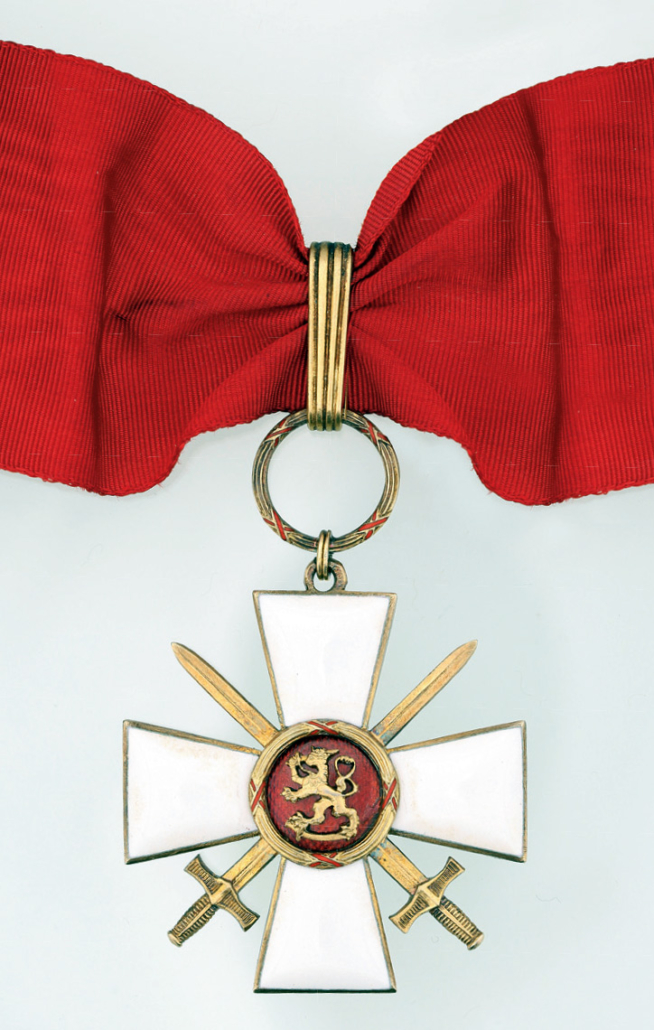
Commander of the Order of the Lion of Finland with Swords.
Oskar Pihl, chief designer at A. Tillander, prepared the final drawings of the decorations for the Order of the Lion of Finland. As with the two older Finnish Orders, the basic form of the cross of the Order of the Lion of Finland is a white cross of the type of the Order of St George. The Lion of Finland was placed at the centre of the cross in a raised red roundel surrounded by a stylized wreath. The color of the Order’s ribbon is red, the same colour as the national coat of arms of Finland. The FL stars are slightly modified versions of the FWR stars.
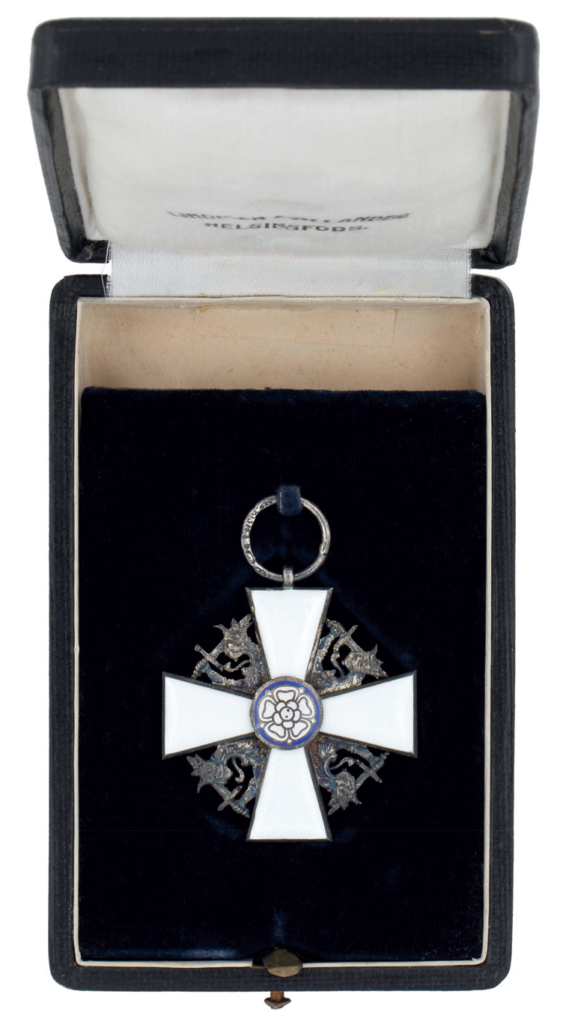
Knight Second Class of the Order of the White Rose of Finland, 1919. The appearance of the Order’s decorations has varied slightly over the years.
When the Order of the White Rose of Finland was established in 1919, its decorations were conferred upon more than one thousand Finnish citizens. In the next two decades, however, the number of Finns receiving decorations was relatively small. The practice of awarding decorations on Independence Day began in 1936, when 270 Finnish citizens were honoured. The first time more than one thousand decorations were conferred was on Independence Day in 1948, and the two thousand mark was reached in 1963. Following that, the numbers grew rapidly, and on Independence Day in 1966 the total conferred was more than three thousand, while in 1971 the total exceeded four thousand and in 1982 five thousand. This growth was principally due to the award of more Medals of the Order of the White Rose of Finland, which meant that the conferral of honours had become more broadly based in society.
Only a small number of modifications have been made to the classes and appearance of the FWR and FL decorations since the Second World War. The swastikas on the collar of the FWR Grand Cross were replaced with fir crosses (‘sprig crosses’) in 1963. Since 1967, it has been possible to confer with a clasp the FL Knight First Class and Knight. The clasp awarded to gold medal winners in the Olympic Games and the Paralympic Games is in the shape of the Olympic symbol.
The FWR Medal Second Class was renamed Medal in 1984. In 1993, the FWR Badge of Merit, which from 1921 onwards had been awarded only to ladies, was discontinued. It was replaced by the Cross of Merit of the Order of the White Rose of Finland, the appearance of which was the same as the Badge of Merit. In 1993, the Order’s bronze Badge of Merit for meritorious military conduct in wartime was removed from the statutes of the Order; the award had never been conferred.
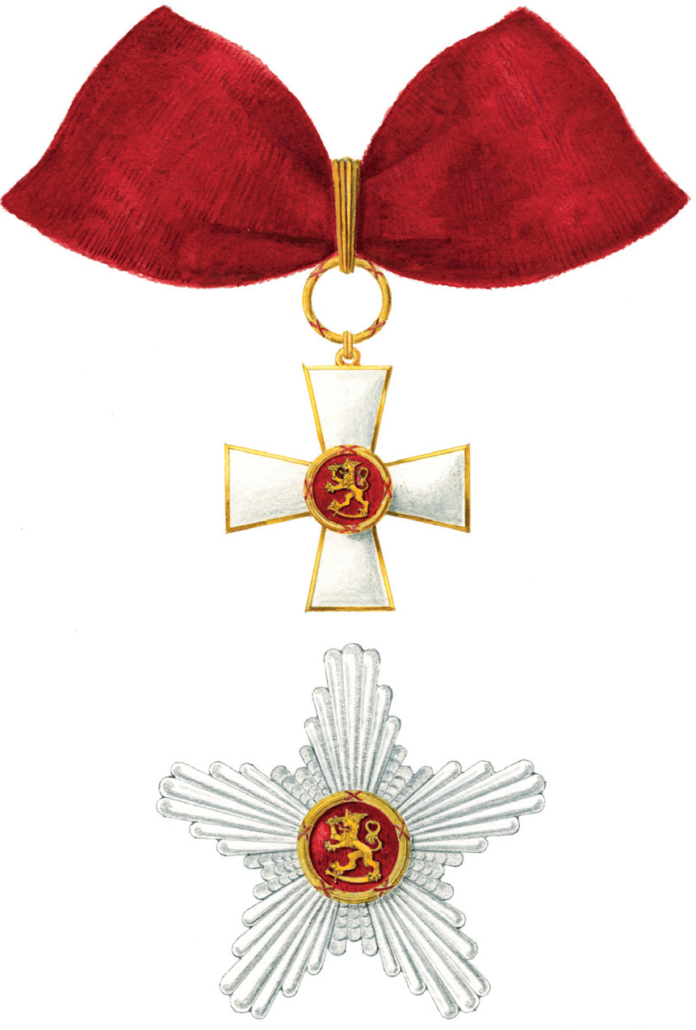
Oskar Pihl’s drawing of Commander First Class of the Order of the Lion of Finland.
In 2008, the duty of foreign nationals to return decorations after the death of the recipient was also removed. There is therefore no requirement to return any decorations of the Orders of the White Rose of Finland and the Lion of Finland.
Changing with the times
The wearing of decorations with civilian attire in Finland was officially restricted to white tie (full evening dress) until 1979. However, prior to 1979, full-size decorations had long been worn extensively with a dark suit and with the corresponding ladies’ attire, especially at formal events for war veterans. In 1979, it was officially permitted to wear full-size decorations and one neck badge with a dark suit or national dress used as formal attire. Since 1990, holders of the Grand Cross and Commander First Class have, with the aforementioned attire, been able to wear one star in addition to the full-size decorations. With a dark suit it is not permitted to wear both a star and a neck badge.
Miniatures previously had to be acquired separately by the recipient, and prior to 1970 their use was restricted mainly to private occasions and to official events where the President of the Republic of Finland was not wearing the Grand Cross with Collar of the Order of the White Rose of Finland. However, since 1970 the wearing of miniatures has been permitted with a white tie (full evening dress) on all occasions at which decorations are worn. Since 1990, it has been possible to wear decorations at black tie (dinner jacket) events, but only miniatures are permitted. Ladies have been able since 1979 to wear miniatures on all occasions at which decorations are worn. Recipients of the Cross of Liberty have received miniatures from the Order since 2009. The Orders of the White Rose of Finland and the Lion of Finland have issued miniatures to Knights and above since 2015.


